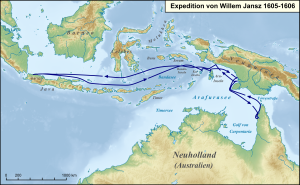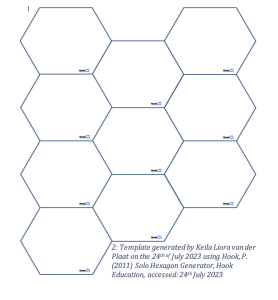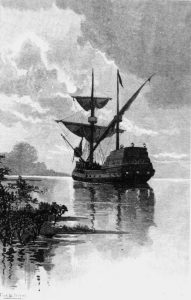18 Dutch Colonialism by Keila Liora van der Plaat
Understanding the relationship between the colonisers and the colonised

Karte Expedition Willem Jansz 1605-1606 by Lencer (CC BY-SA 3.0)
| Curriculum Context | VCE Unit 2: Empires (VCAA, 2020) |
| Historical Context | Empires > Dutch Empire > Encounters, Challenge and Change |
| Historical Thinking Concept | Analyse cause and consequence
|
| Learning Intentions | Classify the key connections of cause and effects of the encounters between the Dutch empire and Aboriginal people. |
Activity
Hexagonal thinking considers connections between ideas to aide you in looking at a problem or idea from multiple perspectives, learning to collaborate with other students and helps you develop more ideas through understanding the connection. This activity will help you engage in historical thinking by formulating connections between the topic, ideas, own thoughts, historical perspectives, primary and secondary resources.
The aim of this activity is to access how your learning has grown regarding understanding connections in the history of Dutch colonialism, specifically the cause and consequences of encounters between the Dutch Empire and the Aboriginal People.
Part 1: Cause and consequence
Working together in groups, use the following resources and your own research to identify cause and consequences of the encounters between the Dutch Empire and Aboriginal People.
In your note taking, include a basic explanation of the event, individuals or groups, historical interpretation, and historical significance. You can use Wikipedia but go to the bottom of the page and find the proper references to the information you are research. You can also use Wikipedia as a starting base to be finding specific resources.
Ensure to properly reference your research – remember to keep the referencing consistent.
Example: Martins, K. (2022) The Dutch Discovery of Australia, World History Encyclopedia, accessed: 24th July 2023.
Part 2: Hexagonal thinking
1. Collect hexagon template and cut it out, start with 20 hexagons (feel free to add).
2. In the centremost hexagon write – Dutch Colonialism in Australia, to establish a starting point.
3. In the surrounding hexagons write different encounters and historical perspectives that you have gathered.
4. Connect them through their causes, consequences, characteristics, historian opinions, and include questions that arose from your research on each hexagon.

Part 3:
All hexagonal creations will be presented to the class for additional note taking and analysing of research techniques.
References
DACC (25th February 2023), First contact between the Dutch and the Aboriginal People, Dutch Australian Cultural Centre, accessed 24th July 2023.
Deadly Story (ND). Invasion of Victoria. https://deadlystory.com/page/culture/history/Invasion
Gonser, S. (16th October 2020) Using ‘Hexagonal Thinking’ to Deepen Classroom Conversations, Edutopia.
Hook, P. (2011) Solo Hexagon Generator, Hook Education, accessed: 24th July 2023
Lencer (2022) Willem Janszoon’s expedition 1605-1606, World History Encyclopedia, New Zealand, Copyright CC BY-NC-SA 4.0
Martins, K. (2022) The Dutch Discovery of Australia, World History Encyclopedia.
National Museum of Australia. (2023). Janszoon maps northern Australian coast. https://www.nma.gov.au/defining-moments/resources/janszoon-maps-northern-australian-coast
VCAA. (2020). VCE Study Design: History 2022-2026. Victorian Curriculum and Assessment Authority. https://www.vcaa.vic.edu.au/curriculum/vce/vce-study-designs/history/Pages/index.aspx
2. How to ask the question and find the answer

The Duyfhen in the Gulf of Carpentaria by Fred. B Sibed, Public Domain
| Curriculum Context | VCE Unit 2: Empires (VCAA, 2020) |
| Historical Context | Empires > Dutch Empire > Encounters, Challenge and Change |
| Historical Thinking Concepts | Ask and use historical questions
Use sources as evidence Construct historical arguments |
| Learning Intentions | Locate and analyse historical sources – primary and secondary – to formulate and answer historical questions.
Research how to ask the relevant historical questions that help with centering Indigenous perspectives. Evaluate the narrative of history is the winner’s interpretation through historical perspectives. Apply historical questions to counteract history’s colonial narrative. |
Activity
1. Watch Were the first European-Australians Dutch? Write up relevant notes and any questions that arose during the video.
2. For this activity, you will work either individually or in pairs to research a list of questions revolving around Indigenous perspectives of the Dutch contact.
The questions are based on literal, inferential and evaluative style questions:
- Literal question stems: Right there on the page, they are identifiable from within your research and draw on your understanding of details (DET 2021).
- Inferential question stems: Think and search between the lines interpret context clues within your research to garner an answer (DET 2021).
- Evaluative question stems: Beyond the text or big picture, this is where you will make a judgement call, opinion based on evidence sourced from your own research (DET 2021).
Use the sources provided and your own research, to answer the questions.
- The Dutch Discovery of Australia
- First contact between the Dutch and the Aboriginal People
- Was there a Dutch colony in Central Australia in the 18th century?
- Dutch in Australia
Provide evidence for both types of statements
- For true, provide evidence with reference that supports the statement.
- For false, provide the correct answer with reference that supports the statement.
Literal Questions
- True or false? There was a Dutch colony in Australia prior to the landing of the British ships.
- True or false? Willem Janszoon was the first to chart two-thirds of the Australian Coastline.
- True or false? The first landing by the Dutch fleet was completely peaceful.
Inferential Questions
- True or false? There are no Indigenous stories or historical records that have been preserved from the landings.
- True or false? The Dutch ‘discovery’ of Australia was a purposeful exploration.
Evaluative Question
- How do the resources silence Aboriginal voices?
3. In groups of 3 compare answers and discuss your answers via evidence.
4. Using your answers and research, develop a historical question which will form the basis for an historical inquiry about who narratives and voices dominate historical interpretations.
References
Bush Tucker Man (19th Oct 2022) ‘Were the first European Australians Dutch?’ ABC Australia, YouTube.
DACC (25th February 2023), First contact between the Dutch and the Aboriginal People, Dutch Australian Cultural Centre.
DACC (10th March 2023), Was there a Dutch colony in Central Australia in the 18th century? Dutch Australian Cultural Centre.
DET (Victorian State Government Department of Education and Training) (2021) Literacy Teaching Toolkit: Comprehension, DET.
Martins, K. (2022) The Dutch Discovery of Australia, World History Encyclopedia.
Scroope, C (2017), Dutch in Australia, Cultural Atlas.
Sibed, F.B. (2022) The Duyfken in the Gulf of Carpentaria, World History Encyclopedia, Copyright Public Domain
VCAA. (2020). VCE Study Design: History 2022-2026. Victorian Curriculum and Assessment Authority. https://www.vcaa.vic.edu.au/curriculum/vce/vce-study-designs/history/Pages/index.aspx

